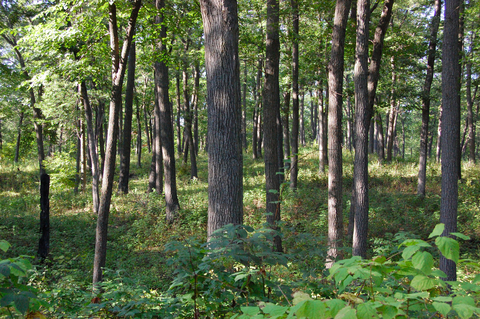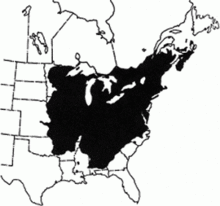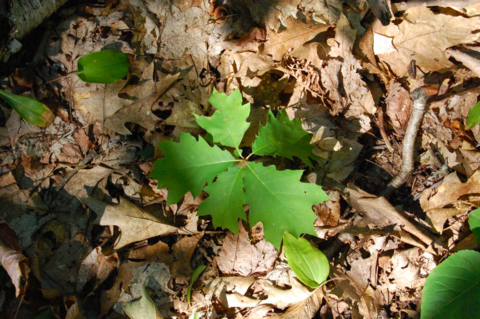Quick facts
- Oak and hickory are commercially valuable for construction products and other uses, like fuelwood.
- Northern red oak, white oak, bur oak, black oak, northern pin oak and various hickories make up an oak-hickory forest.
- Oaks grow best on north- and east-facing, gently sloping, lower slopes where soils are at least 36 inches deep.
- Oaks commonly reproduce from acorns, and stump sprouts after a harvest.
- You can regenerate stands on moderate to good sites when the oaks are 60 to 90 years old and trees average 18 to 24 inches in diameter at breast height
- The red-humped oakworm, two-lined chestnut borer, oak wilt and shoestring root rot are significant pests on oaks.
Oak is valued in furniture, flooring, paneling, railroad ties, cooperage and fuelwood. Hickory, a wood of great strength, has much less market demand but is used for furniture, tool handles, high-strength specialty items, flooring, plywood, fuelwood and charcoal.
The oak-hickory forest is home to many game animals such as white-tailed deer, turkey, gray and fox squirrels and ruffed grouse. Raccoon, opossum, red fox, bobcat, skunk and many birds also take advantage of this forest type.
Growing conditions
Northern red oak, white oak, bur oak, black oak, northern pin oak and various hickories make up an oak-hickory forest.
In this forest, you will also find red and sugar maple, black cherry, American basswood, black walnut, white pine, and white and green ash. If left undisturbed, an oak-hickory stand in the Upper Midwest will shift toward more shade-tolerant species.
Oaks grow best on north- and east-facing, gently sloping, lower slopes where soils are at least 36 inches deep. Medium-quality sites have moderately deep soils (20 to 36 inches) on upper and middle slopes facing north and east.
Oaks survive but grow poorly on narrow ridgetops or south- and west-facing, steep, upper slopes where soil is less than 20 inches deep. Oaks survive better than most other tree species on dry sites, but on these sites they will not produce much timber that is readily sold (called merchantable timber).
On the best sites, there is fierce competition among tree species, so it is difficult to regenerate oaks there.
Northern red oak and white oak are moderately shade-tolerant. In stands with a dense understory or overstory, you will find few oaks in the understory.
Reproducing oaks and hickory
Oaks commonly reproduce from acorns. Northern red oaks produce good acorn crops at two- to five-year intervals. However, seedlings are abundant only after years when excess acorns were not damaged by acorn weevils or consumed by wildlife.
Blue jays, squirrels and gravity usually spread acorns. Acorns germinate best in mineral soil under a light covering of leaves.
Oaks also reproduce from stump sprouts after a harvest. As tree diameter increases, the frequency of oak sprouting declines. Northern red oaks sprout more frequently than white oaks.
Oaks may live for several hundred years. However, for timber production in Minnesota, you can regenerate stands on moderate to good sites when the oaks are 60 to 90 years old and trees average 18 to 24 inches in diameter at breast height (DBH).
A stand also may be ready for harvest and regeneration if it’s greatly understocked or most of its trees are poor quality or an undesirable species.
Natural oak regeneration is most reliable where there’s plenty of seedlings or saplings in the understory (known as advance regeneration).
The number of oak seedlings you will need to successfully stock the next stand depends on seedling size prior to the harvest. The larger the seedlings, the more likely they will survive to harvestable size. For example, you need 15,435 seedlings per acre if they are less than 1 foot tall. If they are all more than 4 feet tall, you need just 514 per acre.
Stands that are well-stocked with advance regeneration, and that have little competition from undesirable understory trees, shrubs or other vegetation, can be clear-cut and successfully regenerated.
A clear-cut should be at least half an acre and preferably at least 2 acres. Otherwise, shade from the surrounding timber will suppress oak seedling growth. For regeneration purposes, there’s no maximum size for clear-cuts.
Reducing shade
If there’s a seed source present but few seedlings, the problem often is too much shade. Acorns may germinate and the seedlings may survive for four or five years beneath heavy shade, but advance oak regeneration will not accumulate over a long period.
To resolve this problem, start by reducing shade produced by the understory of shade-tolerant hardwood trees, shrubs or ferns.
- Cut or treat vegetation with herbicide, depending on the species you want to control.
- If a high canopy produces dense shade, also remove 20 to 40 percent of the canopy.
- Do this via a shelterwood harvest.
- Under this approach, you would leave the species and individual trees that you want to provide seed for the next generation.
- Harvest carefully to avoid damaging residual timber.
After a shelterwood harvest and removing the understory, you may need to wait several years before clear-cutting the stand to ensure you have enough oak seedlings. You may need additional understory control if oaks take more than five years to regenerate.
Waiting for a good acorn crop
An alternative to the shelterwood harvest is waiting until there is a good acorn crop. Then, clear-cut and disturb the soil after the acorns drop, but before the ground freezes. Soil disturbance helps bury the acorns and uproot competing vegetation.
Because of the risk and possible delay when relying on natural regeneration, you may want to plant seedlings. Planting enables you to supplement natural regeneration, use genetically superior stock when it’s available and choose the species.
You can plant seedlings immediately following a shelterwood cut or clear-cut. Before planting, control undesirable trees and shrubs by cutting, bulldozing or treating with herbicide.
The best oak seedlings have a fibrous root system and a stem at least 3/8 inch in diameter. If large seedlings look difficult to handle, just before planting, clip the tops of the seedlings and, if necessary, the roots. Leave each about 8 inches long.
You may need to plant 200 to 800 seedlings per acre, depending on their size and the amount of advance regeneration already in the stand. Control weeds around the oak seedlings for one to two years. Herbicides are often effective and economical for weed control.
Intermediate treatments
Control undesirable tree species that compete with crop trees when stand height averages at least 25 feet (10 to 20 years old).
When growing trees for timber production, thin sprouts growing from a single stump to one or two dominant sprouts. Sprouts should have good form and connect to the stump below or near the ground. Thin when sprouts are about 10 years old (2 to 3 inches in diameter).
When managing oak for timber, keep stands fairly dense until the bottom 20 to 25 feet of the stems are essentially free of live branches. This generally will happen when trees are 40 to 50 feet tall (30 to 45 years).
At this stage, thin stands so crop trees can grow in diameter. Don’t release more than 100 crop trees per acre.
Pruning will improve wood quality. And you may need it if stand density is not high enough to cause natural pruning.
Pest management
The red-humped oakworm, two-lined chestnut borer, oak wilt and shoestring root rot are significant pests on oaks.
To minimize chestnut borer damage, maintain vigorous stands. Specifically, in upland stands with a site index (a measure of a site’s productivity) less than 65, maintain basal areas at:
- Less than 120 square feet per acre in stands with trees averaging 7 to 15 inches diameter at breast height (DBH).
- Less than 100 square feet per acre in stands averaging more than 15 inches DBH.
To calculate basal area, which measures a stand’s density, use the sum of the trees’ cross-sectional areas at breast height. Avoid thinning for five years after a serious drought or defoliation.
To minimize oak wilt infections, don’t thin or prune oaks from mid-April through mid-July. This is when fungal spores are present, and picnic beetles can transport them to fresh wounds. Dormant season operations are best because spores are not present, and the trees are not susceptible to infection.
Because oak wilt commonly spreads through root grafts between neighboring oaks, surround valuable oak stands in high oak wilt hazard areas with a 100-foot buffer of an alternate species. If trees become infected, harvest them before the following spring.
Use a trenching machine or vibratory plow to break the root grafts, which the disease spreads through. Trench placement and depth are critical. Before trenching, consult a forester for advice. Left untreated, oak wilt will spread through the stand until it kills all red oaks. White and bur oaks are not commonly affected by oak wilt.
The red-humped oakworm defoliates oaks late in the year. It causes little growth loss, but weakens the trees and makes them more prone to shoestring root rot and two-lined chestnut borer.
You can spray high-value stands. There are not any changes you can make to the natural environment to control oakworm (no cultural control is available), but maintaining stand vigor should help minimize damage.
CAUTION: Mention of a pesticide or use of a pesticide label is for educational purposes only. Always follow the pesticide label directions attached to the pesticide container you are using. Remember, the label is the law.
Reviewed in 2019





